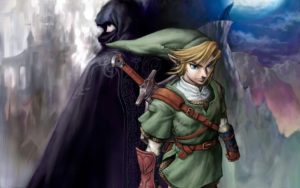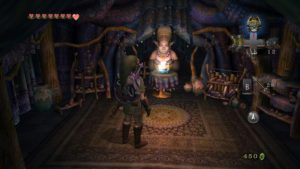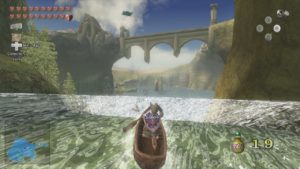Let’s face it: when The Legend of Zelda: Twilight Princess made its debut back in November 2006 it had some really big shoes to fill. In terms of major console releases, it was following in the footsteps of some popular pedigrees: The Legend of Zelda: Ocarina of Time (one of the most highly-regarded games of all time), its 2000 sequel Majora’s Mask, and the expansive, high-seas adventure that was The Legend of Zelda: Wind Waker on the GameCube. The years 2001 to 2005 also marked an explosion of very popular entries on the Game Boy and Game Boy Advance that despite their small size were very much full-on epic adventures.
When I played through Wind Waker, I couldn’t help but wonder what was next for the franchise. In some ways, the game had an air of finality to it. Hyrule had been washed away deep beneath the waves and Ganondorf had been delivered a final death blow with the Master Sword, leaving both he and it sealed beneath the oceans covering what used to be Hyrule. If anything in the series had ever felt like a final moment in the timeline, this was it. Yet, as we came to discover, Nintendo was using the time-bending elements of Ocarina of Time as an excuse to split the timeline into separate branches. Wind Waker, it turned out, was just one of the possible outcomes.
With this in mind, Twilight Princess is set many years after the ending of Ocarina of Time. In this game’s backstory, when Link returns to the time period he was initially from, he warns Princess Zelda of Ganondorf’s plans for the future. The two then convince Zelda’s father, the King of Hyrule, that Ganondorf must be punished lest Hyrule face its eventual destruction, so the King has him executed. Only…Something doesn’t quite go right, and instead of killing him they end up having to seal him within the Twilight Realm. This fact plays an important role later in the game, when we finally come to understand why the Twilight Realm is imposing itself on Hyrule, and who is ultimately motivating its de facto leader, Zant.
I’ll be honest: when it comes to my active play-time with any of the Zelda games out there, The Legend of Zelda: Twilight Princess takes the cake. While I’m sure that I’ll eventually sink in a lot more time with Breath of the Wild on the Switch once I properly dig deep into it, at present no other game comes close to Twilight Princess in terms of time invested into it. At the time, Twilight Princess felt like a large world with a ton of things to see and do. Certainly, it was much larger than Ocarina of Time and perhaps Wind Waker as well (since a lot of that game consisted of open seas). Yet, what caused me to spend more time with this game than any that came before it was the sheer amount of collectibles and upgrades you could get. Gaining all 20 heart containers was no easy feat in itself as there were many sub-quests you had to do in order to get all of them. Also, special upgrades like larger quivers or the magical armor that would make you invincible at the expense of a constant draining of your rupees also necessitated a fairly large investment of your time. But, despite all of this, I had a lot of fun trying to fully complete the game and I have no regrets for the time spent with it.
The dungeons in Twilight Princess are both well thought-out and massive. They are also quite memorable too. The Lakebed Temple and City in the Sky were particularly challenging and interesting to explore. Also, the boss fights were both intense and enjoyable. The boss of the City in the Sky, Argorok, was perhaps the most annoying and difficult boss in the game for me. I’d even go as far as to say defeating it was more laborious than taking down Ganon in the final battle!
One of the things that I remember sticking out to me when I first played Twilight Princess was the fact that the Twilight Realm mechanic felt like it was paying homage to the Dark World from Zelda: A Link to the Past. It was interesting to me to see how the pervading twilight managed to twist and corrupt the things that it came in touch with. I also recall finding it quite refreshing that the game felt more like an epic. In some games, it felt like Link was primarily alone on his quest to save Hyrule, but here you had people that were genuinely aware of what was going on and in some cases people who were ready and willing to help. In fact, there was an entire resistance of able-bodied adults who were with him at major points in the game, even helping storm Hyrule Castle in the game’s penultimate confrontation.
It also had an ending that was a bit of an emotional ride. By the adventure’s end, it was clear that Midna, revealed to be the rightful ruler of the Twilight Realm, had feelings for Link, yet in the game’s final moments when it feels she is about to reveal these feelings to the young hero, she destroys the mirror that connects their two worlds completely. I remember being very angry with that, feeling that she owed to both Link and herself, to be honest about her feelings, and yet she went as far as to destroy any hope they ever had of seeing each other again. It was quite powerful.
While I’ll admit that I haven’t played Twilight Princess HD on the Wii U before, but the 2016 remaster does indeed look quite gorgeous! It even has some nice easter eggs and special content that was added to it to make it stand out a bit more. Obviously, it was sort of a lead-in to this year’s Zelda: Breath of the Wild (which is also available on the Wii U in addition to the Switch), but I’d certainly love to see both this one and Wind Waker HD eventually get ported to the Nintendo Switch.
Ultimately, I think that Twilight Princess managed to pay homage to Ocarina of Time in quite a meaningful way, but it also built off of the successes of that game and created a large world that actually felt alive, begging to be explored. Because of this, 2011’s The Legend of Zelda: Skyward Sword felt like a step back in some ways. The way that the overworld had to be explored felt a lot more closed off and a bit less inviting. Thankfully, Nintendo seemed to listen to its fans and critics and took Breath of the Wild in a completely different direction.
So much of Twilight Princess can be seen in Breath of the Wild that I feel like we owe a bit of thanks to this entry in the long-running franchise. If Twilight Princess was born out of a question of “Where will this series possibly go next? ” I can’t help but think that Breath of the Wild will ultimately yield some of the same questions. Perhaps, though, that will mean that it will eventually yield another amazing follow-up, just as Twilight Princess managed to successfully follow both Ocarina of Time and Wind Waker. If that pattern is to be followed once more, then I can’t help but think that we are in for yet another treat in the hopefully not-too-distant future!
********
If you’ve never played The Legend of Zelda: Twilight Princess (or even if you have!), I hope this article gave you a taste of what made it a fantastic adventure that absorbed so much of my time when it first came out. This article is part of a larger series explores the history of the series and its major entries. Be sure to check out the hub article at NekoJonez’s Arpegi for links to all the great articles and retrospectives on this epic series.
(Image courtesy of ZoeF on DeviantArt)







[…] Now Jessica will be talking about the tales of the Twilight Princess […]
Thanks Jess for writing this article!
I remember Twilight Princess very well. I haven’t fully beaten it yet, but I’m pretty close to the end of the game.
The first time I was able to play this game was on my yearly family trips to the seaside. One of the friends I had there, just got a Wii and got this game in a garage sale.
I was allowed to play it and help them getting through the game. I was so happy that I was allowed to do since at the time, I was researching the Zelda timeline for myself.
I still own the book with notes of those days and looking back on it, it makes me quite nostalgic.
Great writeup Jess. 🙂
I heard a theory that your favourite Zelda game is usually the one that came out when you were about 12. This was that game for me, and it was the first Zelda I completed. It introduced me to this whole new way of adventuring through a world, and told such a story to boot. I think that, although others may surpass it technically, this will always be the one I feel the fondest towards.
That’s certainly an interesting theory. Well, when I was 12 there really wasn’t a new Zelda out. However, Ocarina of Time released a couple years later in the U.S., although despite the fact that I really enjoyed it, I wouldn’t say that it was my favorite.
I’ll probably always be very fond of Zelda: A Link to the Past as well as Wind Waker and Twilight Princess. ALTTP just felt like the perfect experience back when it was new, and in turn I think A Link Between Worlds carries its torch successfully. However, WW and TP were just games that resonated well with me, perhaps because of their stronger narratives and larger game worlds, and so I’d have to rate both of them rather highly!